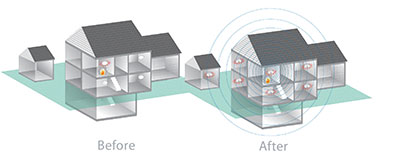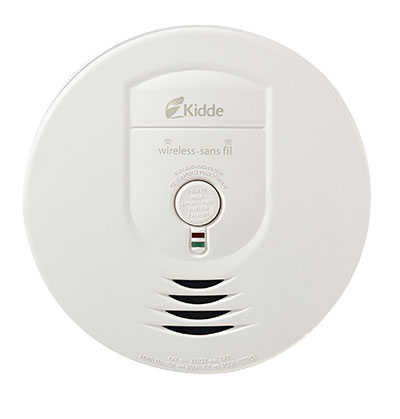
Equipment
Techsmart: wireless safety
A fire in East Gwillimbury, Ont., in March that tragically trapped and killed four members of a single family led to discussions in the media about different types of smoke alarms.
September 10, 2013
By Olivia D’Orazio
A fire in East Gwillimbury, Ont., in March that tragically trapped and killed four members of a single family led to discussions in the media about different types of smoke alarms.
 |
|
| In the event of a fire, all the alarms connected through a wireless system will sound, even if they are not in the vicinity of the fire, ensuring that any occupants have time to escape.
|
The home was equipped with smoke alarms – albeit, not enough of them, according to an investigation by the Office of the Ontario Fire Marshal – but as an interconnected system, hardwired through the room in which the fire started, the alarms failed early into the fire.
Many homes in that neighbourhood, located about 60 kilometres north of Toronto – and in neighbourhoods across the country – are built with similar alarm systems: each alarm is hardwired to the others so that if one alarm sounds, they all do, but, in many cases, if one alarm fails, so do the rest.
Now, manufacturers such as Kidde and First Alert, have developed alarm systems that maintain the benefits of interconnected smoke alarms but mitigate the problems. The systems wirelessly connect each of the alarms in the house using a secure radio frequency; this eliminates the need for wires, and allows the system to be added to an existing home without costly retrofitting.
“Wireless interconnected alarms make it easier for families to protect themselves, and ensure they can escape quickly,” Carol Heller, a home-safety expert with Kidde, explained in
an email.
“This means that the fire service can hopefully attend fires and find more families safely outside at their meeting place.”

|
|
| Wirelessly connected smoke alarms offer the benefits of a hardwired alarm system, but mitigate issues such as costly retrofitting. The alarms also have a remote hush feature. Photo courtesy kidde |
The alarms also offer several features common to other modern alarms, such as photoelectric technology to reduce the occurrence of nuisance alarms, test and silence buttons, and lower-frequency alarm sounds so that those with minor hearing loss can still be alerted.
Robert Comeau, the fire prevention officer for the Quinte West Fire and Emergency Services in Ontario, says his department endorses the wireless alarms.
“We definitely recommend them,” he says.
“You can put them everywhere throughout the house, and by having them interconnected, if you have one activated, every one that’s connected will sound.”
Comeau also points to several other benefits outside of personal protection.
“It saves you a lot of money to use the wireless [alarms] because you don’t need an electrician to add wiring [as with traditional hardwired alarms],” he says.
Kidde’s version of the wireless alarms also feature a remote hush component, so homeowners can quickly silence a nuisance alarm or quiet a low-battery chirp for up to 12 hours. Those types of features also appeal to public educators because they counter homeowners’ arguments for pulling batteries out of sensitive smoke alarms that go off every time the toaster
is used.
For more information on wirelessly interconnected smoke alarms, visit www.firstalert.com or www.kiddecanada.com .
Print this page